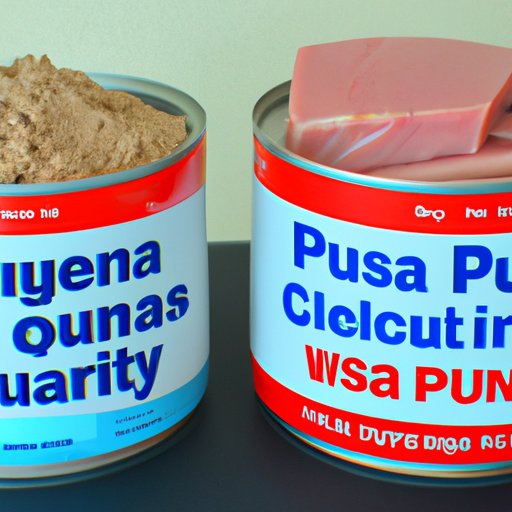Introduction
Canned tuna is one of the most popular foods in the world. It’s convenient, affordable, and packed with nutritional benefits. But is canned tuna healthy? In this article, we’ll explore the nutritional benefits and health risks of canned tuna to help you make an informed decision about whether to include it in your diet.
Examining the Nutritional Benefits of Canned Tuna
Canned tuna is a great source of essential nutrients, including vitamins, minerals, and protein. Let’s take a closer look at some of the key nutritional benefits of canned tuna:
Vitamins and Minerals
Canned tuna is an excellent source of many vitamins and minerals. According to the U.S. Department of Agriculture (USDA), a 3-ounce (85-gram) serving of canned tuna contains the following nutrients:
- Vitamin B12: 24% of the Daily Value (DV)
- Selenium: 33% of the DV
- Niacin: 11% of the DV
- Vitamin B6: 10% of the DV
- Phosphorus: 8% of the DV
These vitamins and minerals are important for a variety of bodily functions, including metabolism, immunity, and nerve function.
Protein Content
Canned tuna is also a good source of protein. A 3-ounce (85-gram) serving of canned tuna provides about 17 grams of protein. Protein is essential for muscle growth and repair and can help keep you feeling full and satisfied.
Omega-3 Fatty Acids
Canned tuna is a good source of omega-3 fatty acids, which are essential fats that your body needs but can’t produce on its own. Omega-3 fatty acids are important for heart health and may help reduce inflammation. A 3-ounce (85-gram) serving of canned tuna contains about 0.2 grams of omega-3 fatty acids.

Exploring Health Concerns Around Canned Tuna
Although canned tuna offers many nutritional benefits, there are also potential health risks associated with it. Let’s look at two of the main health concerns associated with canned tuna:
Mercury Levels
One of the main health concerns with canned tuna is mercury levels. Mercury is a toxic metal that can accumulate in fish, especially larger, predatory fish like tuna. The Environmental Protection Agency (EPA) recommends limiting your intake of canned tuna to no more than 12 ounces (340 grams) per week.
Other Contaminants
Canned tuna can also contain other contaminants, such as polychlorinated biphenyls (PCBs), dioxins, and pesticides. These contaminants can be harmful to your health and have been linked to a variety of health problems, including cancer. The FDA has set limits on the amount of these contaminants allowed in canned tuna.

Comparing Canned Tuna to Other Protein Sources
Now that we’ve explored the nutritional benefits and health risks of canned tuna, let’s compare it to other protein sources. When it comes to protein, there are two main categories: animal proteins and plant-based proteins. Here’s how canned tuna stacks up against each type:
Animal Proteins
Canned tuna is an animal protein, so it can be compared to other animal proteins, such as beef, chicken, and eggs. Compared to these other animal proteins, canned tuna is lower in calories and fat and higher in omega-3 fatty acids. It’s also a more affordable option than many other animal proteins.
Plant-Based Proteins
When it comes to plant-based proteins, canned tuna doesn’t measure up. Plant-based proteins tend to be higher in fiber and antioxidants, while canned tuna is low in both. Plant-based proteins are also typically lower in calories and fat than canned tuna.
Understanding the Environmental Impact of Canned Tuna
In addition to its nutritional benefits and potential health risks, it’s also important to consider the environmental impact of canned tuna. There are two main issues to consider when it comes to the environmental impact of canned tuna: overfishing and bycatch.
Overfishing
Overfishing is a major concern when it comes to canned tuna. Many of the world’s fisheries are being overfished, leading to a decline in fish populations and disruption of marine ecosystems. To minimize the environmental impact of canned tuna, look for brands that use sustainable fishing practices.
Bycatch
Bycatch is another issue to consider when it comes to the environmental impact of canned tuna. Bycatch is when marine animals, such as dolphins and sea turtles, are unintentionally caught in fishing nets. To reduce the amount of bycatch, look for canned tuna brands that use selective fishing gear.
Uncovering the Types of Canned Tuna and Their Health Impacts
When it comes to canned tuna, there are two main types: light and dark. Here’s what you need to know about each type and their health impacts:
Light vs. Dark
Light canned tuna is usually made from skipjack tuna, while dark canned tuna is usually made from albacore tuna. Light canned tuna tends to be lower in mercury than dark canned tuna, so if you’re concerned about mercury levels, opt for light canned tuna.
Wild-Caught vs. Farmed
When it comes to canned tuna, you can also choose between wild-caught and farmed. Wild-caught canned tuna tends to be higher in omega-3 fatty acids than farmed, so if you’re looking for a good source of omega-3s, opt for wild-caught.

Analyzing Labels and Ingredients in Canned Tuna
When buying canned tuna, it’s important to read the label and ingredients list carefully. Here are two things to look out for:
Sodium
Canned tuna is often packed in a brine or oil solution that can be high in sodium. Look for canned tuna that is packed in water or a low-sodium solution.
Additives
Some canned tuna brands add extra ingredients, such as artificial flavors, preservatives, and coloring agents. If possible, opt for brands that don’t add any extra ingredients.
Conclusion
Canned tuna is a popular food item that is packed with nutritional benefits, including vitamins, minerals, protein, and omega-3 fatty acids. However, there are also potential health risks associated with canned tuna, such as mercury levels and other contaminants. It’s important to consider the environmental impact of canned tuna and to read labels and ingredients lists carefully. When consumed in moderation and from sustainable sources, canned tuna can be a healthy part of your diet.
(Note: Is this article not meeting your expectations? Do you have knowledge or insights to share? Unlock new opportunities and expand your reach by joining our authors team. Click Registration to join us and share your expertise with our readers.)
